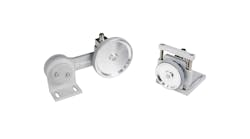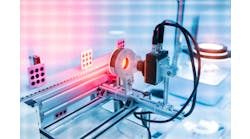By Loren Shaum
In the late 60s, industry discovered how to etch lines precisely on a small glass disc--enough lines to measure at the 0.01 range when translated through the machine mechanics. As the technology improved, encoders became the dominant rotary and linear displacement measurement means. Today encoder technology dominates North America and Asia, while resolvers still hold a strong presence in Europe.
Pepper+Fuchs (P+F) has a new position tracking system for vertical carrier mechanisms such as elevators. PosiTracks U-shaped read-head optically scans a uniquely coded rail to determine position. An internal microprocessor translates a 48 sender/receiver LED array status into a 19-bit code, providing 0.8 mm positional resolution over travel distances to 1,070 ft. Communication is via RS-485 or synchronous serial interface (SSI), or it can be converted to almost any standard network bus protocol using a P+F interface. PosiTrack read-heads require no calibration.
In critical applications, monitoring light-source strength is very key. The PosiTrack read-head provides a maintenance control signal well before system integrity is compromised. PosiTracks rail/read-head alignment tolerances and internal compensation for rail-code irregularities maximize system uptime, says Marcel Ulrich, P+F product manager. Detailed system diagnostic codes are continuously provided, so a controller is never more than a few milliseconds away from verifying system health.
MTS Systems (MTS) recently expanded its Temposonics intelligent sensors with the R-Series EtherCat sensor. Built around wave-guide technology, the sensor can be used with one to five position magnets and customized to document position, velocity, and acceleration. Position resolution is said to be accurate to 1 µm, speed to 0.2 mm/s based on a sensor update rate of 100 µs, independent of stroke. A nonlinearity correction option allows accuracies to +/-0.02 mm.
Another alternative in high-accuracy applications is inductive incremental encoder technology. Although initially requiring more precise manufacturing and assembly operations, the result is very small position measurement capability. AMO developed technology that involves scanning high-precision graduations, which are etched via photolithography on a stainless steel ring for rotary encoding or a flat strip for linear measurements. This process allows a minimum grating pitch of 1 mm.
AMO encoders operate on the same principle as a transformer, but with a moving reluctance core. The sensing-head coils are aligned in the direction of measurement and precisely etched on a substrate using micro-multi-layer technology. Each coil consists of several windings, one set producing a sine-wave output, the other a cosine.
During motion, the relative angular movement in the direction of measurement between the sensing head and the scale changes the mutual inductance of the individual coils, generating the sine and cosine signals. The resulting signal can be very precise and is immunized against environment influences. The signal then is conditioned and converted through a proprietary ASIC. Deviations are said to be less than 0.1% from an ideal sinusoidal waveform.
To create an industrially rugged encoder assembly using this technology requires precise welding of the linear scale and attaching it to a precision circumference ring.
Because the sensing coils are on a flexible substrate, the head can be adapted to virtually any diameter. The result is a hollow-shaft encoder that can be used at speeds as high as 23,000 rpm, and providing resolution to 0.25 µm when using digital interpolation techniques.
Sick Stegmann is one of the creators of the SSI communication standard for encoder interfacing. The company recently released its DRS61 CoreTech incremental encoder with a USB connection and programming software to program encoders for 1 to 8,192 pulses per resolution (PPR) and for the width of the reference pulse. This flexible programmability provides users a single type of encoder that can be programmed at any time, in any location and for any application, says Scott Hewitt, president, Sick Stegmann U.S. Customer programmability is a particularly attractive feature for end users, OEMs, consultants, system integrators and automation distributors.
An application where the programmable encoder plays a key role is in computer-controlled textile machines. Encoder information from these machines is used for three functions: Master sensor for the main shaft, speed regulation for drives and position control for the thread-feed computer.
| About the Author |




